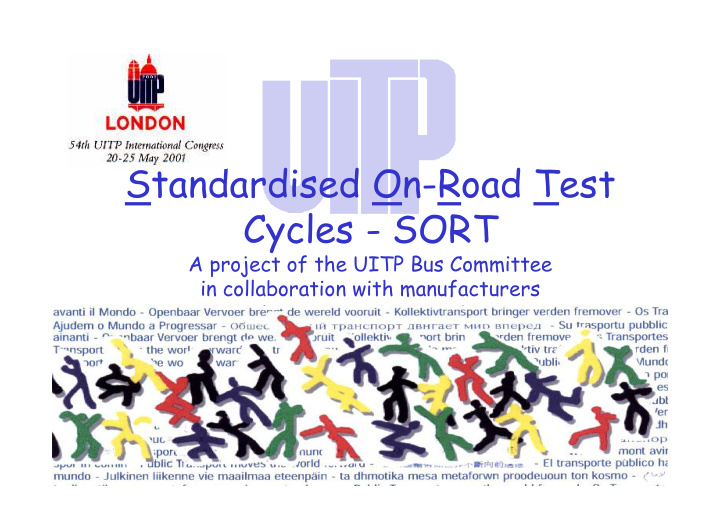



Standardised On-Road Test Cycles - SORT A project of the UITP Bus Committee in collaboration with manufacturers
2 et d = 2 m/s 2 Cycle Urbain : a = 1m/s V 70 Vc=12,97 km/h 60 50 40 30 20 10 0 0 200 400 600 800 1000 1200 1400 1600 distance TEC Urban Cycle
55 60 Cycle RATP AQA21 45 50 Series1 Series2 35 40 25 30 15 20 5 10 -5 0 200 400 600 800 1000 1200 1400 1600 1800 2000 -15 0 RATP Aqa 21 Cycle
Fahrzyklus zur Kraftstoffverbrauchsmessung 70 750m 60 500m 400m 400m 400m 400m 400m 50 Fahrzeuggeschw. [km/h] 40 300m 200m 300m 200m 30 250m 250m 250m 20 Stop 10 sec 10 Stop 40 sec. 0 0 250 500 750 1000 1250 1500 1750 2000 2250 2500 2750 3000 3250 3500 3750 4000 4250 4500 4750 5000 Streckenlänge [m] Evobus Cycle
Objectives � Ecological � Normative � Technical � Contractual � Economical
Ecological reasons • (pollution) • consumption • new technologies - results – reliability – comparability
Normative reasons • Limited relevance of EC norms • “13 mode” test • new European cycles � need to test entire vehicles • (results expressed in g/k) • real operation conditions • objective comparison
Technical reasons • Large array of cinematic chains possible for same vehicle • Simplify process of vehicle choice and optimisation • Avoid quick conclusions in bids • Availability of comparative information – between models – between technologies
Contractual reasons • Guarantees on performances consumption • Possibility to compare bids • Relevance of a contractual cycle
Economical reasons • Minimise operation costs • Minimise costs for official acceptance and conformity control tests
Standardised on-road cycles = Advantage for all parties • Operators • Manufacturers • Certifiers But issues remain to be solved….
Vehicle Performance Vehicle load Line Topography Obstacles – Congestion - Stops Boarding time Acceleration Agreed speed COMMERCIAL SPEED CONSUMPTION
CONSUMPTION IS STRONLY INTERTWINED WITH COMMERCIAL SPEED (Source : RATP) Numbers indicate line identification. 70 62 92 60 39 89 68 Diesel Consumption 321 128 104 117 308 206 187 211 221 192 319 5 10 15 20 25 Commercial speed (km/h)
• How to design cycles suitable to all? • Condition for large scale use • How to neutralise external factors? • Condition for repeatability • How to design simple cycles? • Feasibility condition
Quality of cycles • representative • normative • repeatable • easy to use
Cycles Speed Section 3 Section 2 Section 1 ST OP 2 3 D A Time T 0 T 1 T 3 T 3 Module 1 Module 2 COMPLETE CYCLE
Urban Operation Suburban Operation Heavy urban Easy urban Suburban 17 km/h 12 km/h 27 km/h
0 6.2 Heavy urban Cycle 13.8 19.4 26.9 30.4 45 38.7 38.7 38.7 40 38.7 68.7 78.8 35 81.7 92.8 30 Speed (Km/h) 25 20 15 10 5 0 0 10 20 30 40 50 60 70 80 90 100 time (s)
0.0 17.1 Easy Urban Cycle 59.6 75.0 106.6 135.3 170.0 170.0 60 170.0 170.0 170.0 266.5 50 423.5 520.0 40 Speed (km/h) 30 20 10 0 0 100 200 300 400 500 600 distance (m)
Suburban Cycle 0 7.6 11.0 80 19.4 29.5 32.3 70 43.5 57.3 68.7 60 82.5 112.5 138.6 50 Speed (Km/h) 149.2 170.1 40 30 20 10 0 0 20 40 60 80 100 120 140 160 180 time (s)
Urban Operation Suburban Operation Heavy urban Easy urban Suburban 17 km/h 12 km/h 27 km/h
Influence of external factors • Rolling resistance – independent factors – manufacturer’s bound factors • Driver ⇒ relevant to carry out tests on track with computer-aided driving…
Characteristics of vehicle to be tested • half load (3.2 t) • standard basis equipment (legal) • no accessories operating • door open/close operation at end of a module • run-in engine (10 to 15.000 km) • nominal tuning (pressure etc) – accessories are tested separately…
SORT should become a standard
Standardised On-Road Test Cycles - SORT A project of the UITP Bus Committee in collaboration with manufacturers
Recommend
More recommend